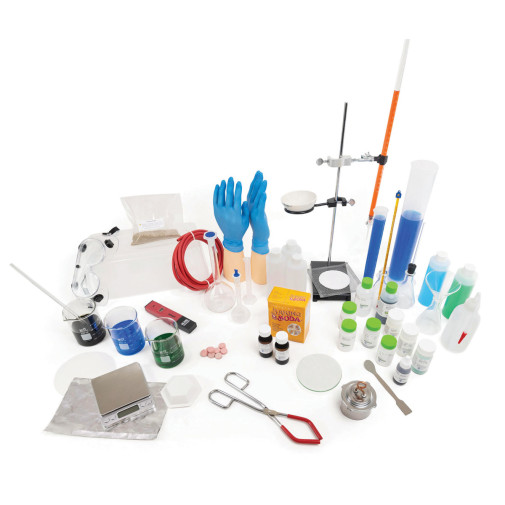We use cookies to make your experience better. To comply with the new e-Privacy directive, we need to ask for your consent to set the cookies. Learn more.
Novare General Chemisty Lab Kit
- Small parts. Not for children under 3 years.
Kit includes: 1 Acetic Acid Solution 1 M, 100 mL
1 Alcohol burner
1 Aluminum foil
1 Antacid tablet, pack
1 Baking soda
1 Balance
1 Beaker, glass, 250 mL
1 Benzoic Acid, 15 g
1 Bottle, 250 mL
1 Bromothymol Blue, 100 mL
1 Buret
1 Buret clamp
1 Copper II Chloride, 30 g
1 Erlenmeyer flask, 100 mL
1 Evaporating dish
1 Filter paper, pack
1 Funnel
1 Glass tube
1 Gloves, pair
1 Goggles
1 Graduated cylinder, 10mL
1 Graduated cylinder, 100 mL
1 Graduated cylinder, 500 mL
1 Hydrochloric Acid, 12 Molar, 30 mL
1 Lab apron
1 Litmus aqueous solution, 0.5%, 30 mL
1 Oxalic Acid, 30 g
1 pH meter
1 Plastic box
1 Potassium Hydrogen Phthalate, 15 g
1 Ring stand and ring
1 Rubber stopper, 1-hole
1 Sand
1 Sodium Chloride, 30 g
1 Sodium Hydroxide, 30 g
1 Spatula
1 Stirring rod, glass
1 Thermometer
1 Tongs
1 Tubing
1 Volumetric flask, 250 mL
1 Volumetric flask, 50 mL
1 Wash bottle
1 Watch glass
1 Weigh boats, pack
1 Wire gauze
1 Zinc Mossy, 30 g
Intended for use at the 11th grade level, this mastery-based chemistry course takes a bit of a different approach from other chemistry courses. Focusing on fewer topics with more depth, Novare Science takes a Kingdom Perspective to current scientific theories. Prior to the course, students should have successfully completed Algebra 1, Introductory Physics and Biology. Algebra 2 should be taken concurrently. By following the author's suggestion of physics first, the student can more easily work through General Chemistry and have a greater understanding of the concepts. Through General Chemistry, students are brought into the real world of chemistry through detailed and clearly explained text, laboratory experiments, and carefully constructed exercises and quizzes. The history of modern chemistry, mathematics and technical communication is emphasized throughout. Typically, you need a lab component with chemistry courses. No labs are included in the Student Text, so the author recommends Chemistry Experiments for High School at Home for those who are homeschooling. This book has low-cost alternatives to expensive equipment and recommendations for procuring small quantities of chemicals. Optional and helpful resources include the Student Lab Report Handbook and the optional Lab Kit. Required components include the Student Edition Text, Digital Resources, Complete Solutions and Answers, and the Chemistry Experiments for High School at Home to meet the lab requirements on your high school transcript. Available separately or as a convenient package for the full Program.
| Product Format: | Other |
|---|---|
| Grades: | 11-12 |
| Brand: | Home Science Tools |
| Length in Inches: | 12.5 |
| Width in Inches: | 13.25 |
| Height in Inches: | 19.625 |
| Weight in Pounds: | 13.9 |
Be the first to review this item


requested